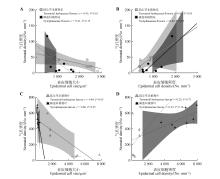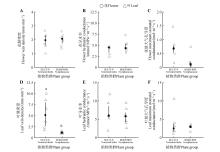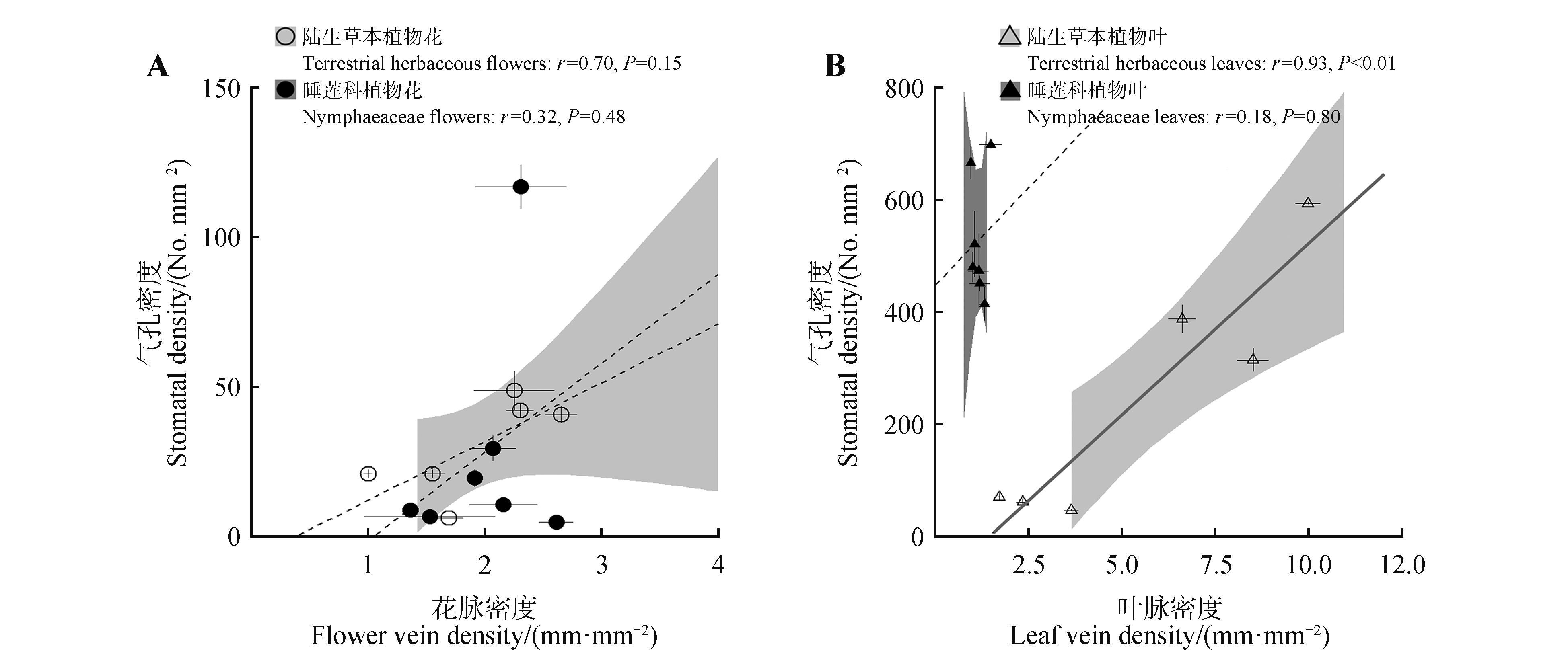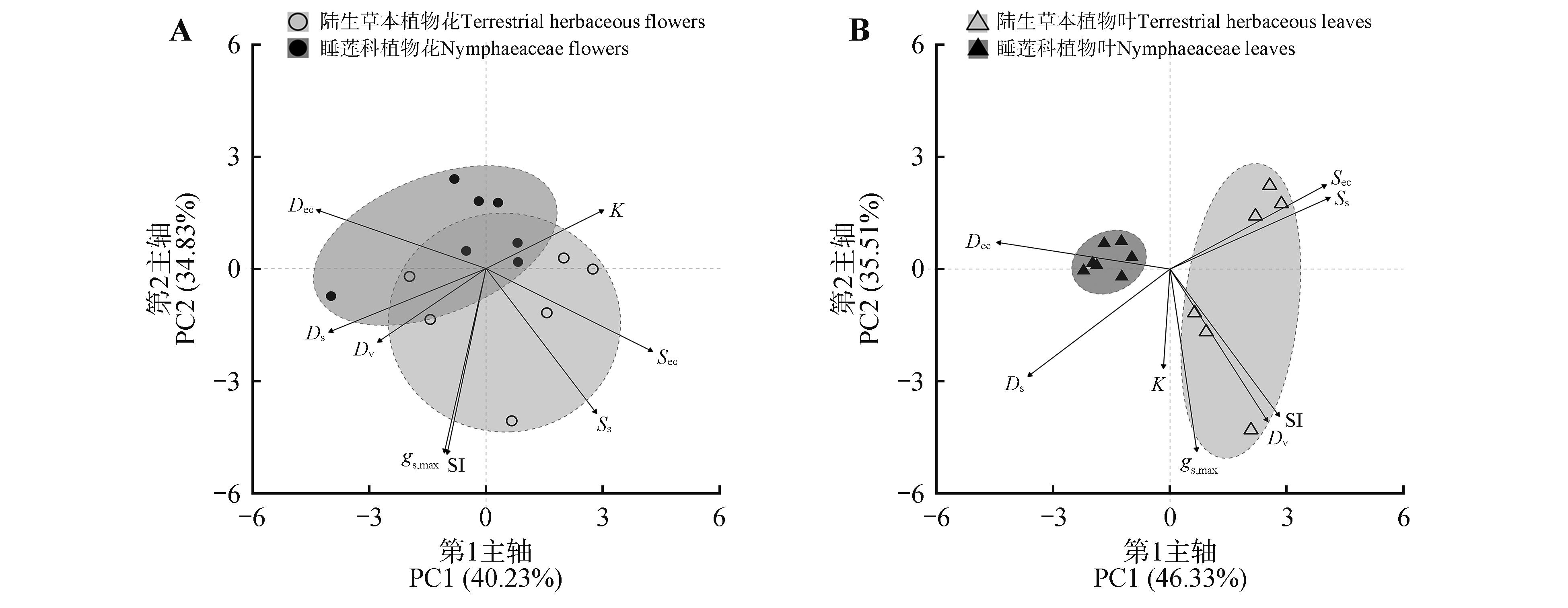Bulletin of Botanical Research ›› 2025, Vol. 45 ›› Issue (5): 675-685.doi: 10.7525/j.issn.1673-5102.2025.05.003
• Original Paper • Previous Articles Next Articles
Xinyi HU1, Liming XU2( ), Botao QIN1, Yidong AN1, Guofeng JIANG1(
), Botao QIN1, Yidong AN1, Guofeng JIANG1( )
)
Received:2025-03-06
Online:2025-09-20
Published:2025-09-28
Contact:
Liming XU, Guofeng JIANG
E-mail:dawn111305@163.com;gfjiang@gxu.edu.cn
CLC Number:
Xinyi HU, Liming XU, Botao QIN, Yidong AN, Guofeng JIANG. Distinct Water Supply and Consumption Characteristics in Leaves between Nymphaeaceae and Terrestrial Herbs[J]. Bulletin of Botanical Research, 2025, 45(5): 675-685.
Table 1
List of studied species
序号 No. | 物种名 Name | 科 Family | 属 Genus | 生长型 Growth form |
|---|---|---|---|---|
| 1 | 鬼针草Bidens pilosa | 菊科Compositae | 鬼针草属Bidens | 陆生草本Terrestrial herb |
| 2 | 蓝花草Ruellia simplex | 爵床科Acanthaceae | 芦莉草属Ruellia | 陆生草本Terrestrial herb |
| 3 | 水鬼蕉Hymenocallis littoralis | 石蒜科Amaryllidaceae | 水鬼蕉属Hymenocallis | 陆生草本Terrestrial herb |
| 4 | 韭莲Zephyranthes carinata | 石蒜科Amaryllidaceae | 葱莲属 Zephyranthes | 陆生草本Terrestrial herb |
| 5 | 葱莲Zephyranthes candida | 石蒜科Amaryllidaceae | 葱莲属 Zephyranthes | 陆生草本Terrestrial herb |
| 6 | 红掌Anthurium andraeanum | 天南星科Araceae | 花烛属Anthurium | 陆生草本Terrestrial herb |
| 7 | 睡莲Nymphaea tetragona | 睡莲科Nymphaeaceae | 睡莲属Nymphaea | 水生草本Aquatic herb |
| 8 | 喀麦隆睡莲Nymphaea zenkeri | 睡莲科Nymphaeaceae | 睡莲属Nymphaea | 水生草本Aquatic herb |
| 9 | 齿叶睡莲Nymphaea lotus | 睡莲科Nymphaeaceae | 睡莲属Nymphaea | 水生草本Aquatic herb |
| 10 | 蓝睡莲Nymphaea nouchali var. caerulea | 睡莲科Nymphaeaceae | 睡莲属Nymphaea | 水生草本Aquatic herb |
| 11 | 印度红睡莲Nymphaea rubra | 睡莲科Nymphaeaceae | 睡莲属Nymphaea | 水生草本Aquatic herb |
| 12 | 变色睡莲Nymphaea atrans | 睡莲科Nymphaeaceae | 睡莲属Nymphaea | 水生草本Aquatic herb |
| 13 | 萍蓬草Nuphar pumila | 睡莲科Nymphaeaceae | 萍蓬草属Nuphar | 水生草本Aquatic herb |
Table 2
Mean anatomical indexes of flowers and leaves of Nymphaeaceae and terrestrial herbs
器官 Organ | 植物类群 Plant group | 气孔大小 Stomatal size/μm2 | 表皮细胞大小 Epidermal cell size/μm2 | 气孔密度 Stomatal density/ (No. mm-2) | 表皮细胞密度 Epidermal cell density/(No. mm-2) | 气孔指数 Stomatal index | 脉密度 Vein density/ (mm∙mm-2) |
|---|---|---|---|---|---|---|---|
花 Flower | 陆生草本植物 Terrestrial plants | 864.12±124.02Aa | 2 003.17±335.16Aa | 26.65±6.42Ab | 528.40±102.49Aa | 5.09±1.09Ab | 1.91±0.25Ab |
睡莲科植物 Nymphaeaceae | 618.88±71.94Aa | 1 125.06±170.51Ba | 27.89±15.15Ab | 965.03±189.23Ab | 2.51±0.70Ab | 1.99±0.16Aa | |
叶 Leaf | 陆生草本植物 Terrestrial plants | 1 088.04±243.97Aa | 3 779.24±1 039.91Aa | 244.85±91.55Ba | 221.02±76.53Bb | 41.93±10.46Aa | 5.45±1.39Aa |
睡莲科植物 Nymphaeaceae | 292.90±11.35Bb | 276.74±36.01Bb | 529.22±41.66Aa | 3 032.91±293.07Aa | 15.24±1.18Ba | 1.15±0.07Bb |

Fig.1
The correlation diagrams of stomatal density(Ds) with epidermal cell size(Sec)(A) and epidermal cell density (Dec) (B) in flowers of Nymphaeaceae and terrestrial herbaceous plants, as well as stomatal density (Ds) with epidermal cell size(Sec) (C) and epidermal cell density(Dec) (D) in leavesThe dashed lines and r values represented the linear regression results with significance levels(P), where black indicated Nymphaeaceae plants and gray denoted terrestrial herbaceous plants. Solid lines meant statistically significant trait correlations, while dashed lines indicated no significant correlation. The shaded areas represented 95% confidence intervals. Error bars indicated standard errors. Given the magnitude variations in size and density per unit area, different measurement units were adopted to facilitate more intuitive data visualization.


Fig.2
Comparison of vein density (Dv),water conductivity (K),and maximum stomatal conductance (gs,max) between Nymphaeaceae and terrestrial herbsDifferent lowercase letters indicated significant differences between groups. The interquartile range(IQR) and median were displayed using solid black dots and error bars for each individual group. Differences between traits were obtained by independent samples t-test.


Fig.3
Correlation between stomatal density(Ds) and vein density(Dv) of Nymphaeaceae and terrestrial herb organsThe dashed lines and r values represented the linear regression results with significance levels (P), where black indicated Nymphaeaceae plants and gray denoted terrestrial herbaceous plants. Solid lines meant statistically significant trait correlations, while dashed lines indicated no significant correlation. The shaded areas represented 95% confidence intervals. Error bars indicated standard errors.


Fig.4
Principal component analysis(PCA) of eight traits for flowers(A) and leaves(B) of all species(n=13)The shaded areas represented the total trait space volume occupied by Nymphaeaceae(n=7) and terrestrial herbs(n=6). Black arrows indicated the loadings of traits, including epidermal cell size(Sec), stomatal size(Ss), epidermal cell density(Dec), stomatal density(Ds), vein density(Dv), stomatal index(SI), hydraulic conductivity(K), and maximum stomatal conductance(gs,max).

| [1] | SACK L, HOLBROOK N M.Leaf hydraulics[J].Annual Review of Plant Biology,2006,57:361-381. |
| [2] | 龚容,高琼.叶片结构的水力学特性对植物生理功能影响的研究进展[J].植物生态学报,2015,39(3):300-308. |
| GONG R, GAO Q.Research progress in the effects of leaf hydraulic characteristics on plant physiological functions[J].Chinese Journal of Plant Ecology,2015,39(3):300-308. | |
| [3] | SACK L, SCOFFONI C.Leaf venation:structure,function,development,evolution,ecology and applications in the past,present and future[J].New Phytologist,2013,198(4):983-1000. |
| [4] | GINDEL I.Stomatal number and size as related to soil moisture in tree xerophytes in Israel[J].Ecology,1969,50(2):263-267. |
| [5] | CLIFFORD S C, BLACK C R, ROBERTS J A,et al.The effect of elevated atmospheric CO2 and drought on stomatal frequency in groundnut (Arachis hypogaea L.)[J].Journal of Experimental Botany,1995,46(7):847-852. |
| [6] | SALISBURY E J.On the causes and ecological significance of stomatal frequency,with special reference to the woodland flora[J].Philosophical Transactions of the Royal Society of London Series B,1928,216:1-65. |
| [7] | ZHAO W L, FU P L, LIU G L,et al.Difference between emergent aquatic and terrestrial monocotyledonous herbs in relation to the coordination of leaf stomata with vein traits[J].AoB Plants,2020,12(5):plaa047. |
| [8] | CARINS MURPHY M R, JORDAN G J, BRODRIBB T J.Acclimation to humidity modifies the link between leaf size and the density of veins and stomata[J].Plant,Cell & Environment,2014,37(1):124-131. |
| [9] | CARINS MURPHY M R, JORDAN G J, BRODRIBB T J.Cell expansion not cell differentiation predominantly co-ordinates veins and stomata within and among herbs and woody angiosperms grown under sun and shade[J].Annals of Botany,2016,118(6):1127-1138. |
| [10] | CARINS MURPHY M R, JORDAN G J, BRODRIBB T J.Ferns are less dependent on passive dilution by cell expansion to coordinate leaf vein and stomatal spacing than angiosperms[J].PLoS One,2017,12(9):e0185648. |
| [11] | CARINS MURPHY M R, JORDAN G J, BRODRIBB T J.Differential leaf expansion can enable hydraulic acclimation to sun and shade[J].Plant,Cell & Environment,2012,35(8):1407-1418. |
| [12] | BRODRIBB T J, JORDAN G J, CARPENTER R J.Unified changes in cell size permit coordinated leaf evolution[J].New Phytologist,2013,199(2):559-570. |
| [13] | SCHNEIDER J V, HABERSETZER J, RABENSTEIN R,et al.Water supply and demand remain coordinated during breakdown of the global scaling relationship between leaf size and major vein density[J].New Phytologist,2017,214(1):473-486. |
| [14] | BLONDER B, SALINAS N, PATRICK BENTLEY L,et al.Predicting trait-environment relationships for venation networks along an Andes-Amazon elevation gradient[J].Ecology,2017,98(5):1239-1255. |
| [15] | ZHAO W L, CHEN Y J, BRODRIBB T J,et al.Weak co-ordination between vein and stomatal densities in 105 angiosperm tree species along altitudinal gradients in southwest China[J].Functional Plant Biology,2016,43(12):1126-1133. |
| [16] | 张亚,杨石建,孙梅,等.基部被子植物气孔性状与叶脉密度的关联进化[J].植物科学学报,2014,32(4):320-328. |
| ZHANG Y, YANG S J, SUN M,et al.Stomatal traits are evolutionarily associated with vein density in basal angiosperms[J].Plant Science Journal,2014,32(4):320-328. | |
| [17] | HOVENDEN M J, VANDER SCHOOR J K, OSANAI Y.Relative humidity has dramatic impacts on leaf morphology but little effect on stomatal index or density in Nothofagus cunninghamii(Nothofagaceae)[J].Australian Journal of Botany,2012,60(8):700-706. |
| [18] | RODDY A B, DAWSON T E.Determining the water dynamics of flowering using miniature sap flow sensors[J].Acta Horticulturae,2011,951:47-53. |
| [19] | RODDY A B, BRODERSEN C R, DAWSON T E.Hydraulic conductance and the maintenance of water balance in flowers[J].Plant,Cell & Environment,2016,39(10):2123-2132. |
| [20] | ZHANG F P, CARINS MURPHY M R, CARDOSO A A,et al.Similar geometric rules govern the distribution of veins and stomata in petals,sepals and leaves[J].New Phytologist,2018,219(4):1224-1234. |
| [21] | RODDY A B, GUILLIAMS C M, LILITTHAM T,et al.Uncorrelated evolution of leaf and petal venation patterns across the angiosperm phylogeny[J].Journal of Experimental Botany,2013,64(13):4081-4088. |
| [22] | KE Y, ZHANG F P, ZHANG Y B,et al.Convergent relationships between flower economics and hydraulic traits across aquatic and terrestrial herbaceous plants[J].Plant Diversity,2023,45(5):601-610. |
| [23] | DE LA BARRERA E, NOBEL P S.Nectar:properties,floral aspects,and speculations on origin[J].Trends in Plant Science,2004,9(2):65-69. |
| [24] | 武晓倩,何旭,高境烩,等.转PsnNAC007高耐旱性小黑杨种质创制及其特性分析[J].植物研究,2024,44(3):349-360. |
| WU X Q, HE X, GAO J H,et al.Germplasm innovation and characteristic analysis of transgenic PsnNAC007 Populus simonii×P.nigra with high drought tolerance[J].Bulletin of Botanical Research,2024,44(3):349-360. | |
| [25] | GISLERØD H R, MORTENSEN L M.Relative humidity and nutrient concentration affect nutrient uptake and growth of Begonia×hiemalis [J].HortScience,1990,25(5):524-526. |
| [26] | 孙媛媛,杨添琪,艾星梅,等.热带睡莲展叶前后叶片形态结构差异与叶脐胎芽发育的关系[J].植物研究,2024,44(4):528-539. |
| SUN Y Y, YANG T Q, AI X M,et al.Relationship between the differences in leaves morphology and structure and epiphyllous bud development of tropical water lily before and after leaf expansion[J].Bulletin of Botanical Research,2024,44(4):528-539. | |
| [27] | 周庆源.睡莲科的花的生物学和生殖形态学研究[D].北京:中国科学院植物研究所,2005. |
| ZHOU Q Y.Floral biology and reproductive morphology of the Nymphaeaceae[D].Beijing:Institute of Botany,Chinese Academy of Sciences,2005. | |
| [28] | 胡光万,刘克明,雷立公.睡莲科三属植物叶的比较解剖学研究[J].生命科学研究,2003,7(3):243-248. |
| HU G W, LIU K M, LEI L G.Comparative study on leaf anatomy of three genera in Nymphaeaceae[J].Life Science Research,2003,7(3):243-248. | |
| [29] | 刁英,胡蓉,游永宁,等.莲属植物叶片及花瓣的比较解剖学研究[J].湖北农业科学,2013,52(13):3059-3061. |
| DIAO Y, HU R, YOU Y N,et al.Comparative anatomy studies on leaves and petals of Nelumbo [J].Hubei Agricultural Sciences,2013,52(13):3059-3061. | |
| [30] | 许梅芝.睡莲气孔细胞结构进化的分子机制[D].福州:福建农林大学,2018. |
| XU M Z.The molecular basis of the evolution of stomatal complex in Nymphaea colorata [D].Fuzhou:Fujian Agriculture and Forestry University,2018. | |
| [31] | FRANKS P J, FARQUHAR G D.The effect of exogenous abscisic acid on stomatal development,stomatal mechanics,and leaf gas exchange in Tradescantia virginiana [J].Plant Physiology,2001,125(2):935-942. |
| [32] | FRANKS P J, DRAKE P L, BEERLING D J.Plasticity in maximum stomatal conductance constrained by negative correlation between stomatal size and density:an analysis using Eucalyptus globulus [J].Plant,Cell & Environment,2009,32(12):1737-1748. |
| [33] | DE BOER H J, DRAKE P L, WENDT E,et al.Apparent overinvestment in leaf venation relaxes leaf morphological constraints on photosynthesis in arid habitats[J].Plant Physiology,2016,172(4):2286-2299. |
| [34] | BRODRIBB T J, FEILD T S.Leaf hydraulic evolution led a surge in leaf photosynthetic capacity during early angiosperm diversification[J].Ecology Letters,2010,13(2):175-183. |
| [35] | 周勇,操粮骏,何泽娟,等.超低温对咖啡豆中非挥发性风味品质及超微结构的影响[J].食品科学技术学报,2025,43(3):89-101. |
| ZHOU Y, CAO L J, HE Z J,et al.Effect of ultra-low temperature on non-volatile flavor quality and ultrastructure of coffee beans[J].Journal of Food Science and Technology,2025,43(3):89-101. | |
| [36] | THÉROUX-RANCOURT G, RODDY A B, EARLES J M,et al.Maximum CO2 diffusion inside leaves is limited by the scaling of cell size and genome size[J].Proceedings of the Royal Society B,2021,288(1945):20203145. |
| [37] | KÖRNER C.Leaf diffusive conductances in the major vegetation types of the globe[M]//SCHULZE E D,CAL-DWELL M M.Ecophysiology of Photosynthesis.Berlin:Springer,1995:463-490. |
| [38] | TERASHIMA I, MIYAZAWA S I, HANBA Y T.Why are sun leaves thicker than shade leaves? — consideration based on analyses of CO2 diffusion in the leaf[J].Journal of Plant Research,2001,114(1):93-105. |
| [39] | SACK L, DIETRICH E M, STREETER C M,et al.Leaf palmate venation and vascular redundancy confer tolerance of hydraulic disruption[J].Proceedings of the National Academy of Sciences of the United States of America,2008,105(5):1567-1572. |
| [40] | RAVEN J A.Selection pressures on stomatal evolution[J].New Phytologist,2002,153(3):371-386. |
| [41] | JAVELLE M, VERNOUD V, ROGOWSKY P M,et al.Epidermis:the formation and functions of a fundamental plant tissue[J].New Phytologist,2011,189(1):17-39. |
| [42] | TORII K U.Stomatal development in the context of epidermal tissues[J].Annals of Botany,2021,128(2):137-148. |
| [43] | NOBEL P S.Biophysical plant physiology and ecology[M].San Francisco:W.H.Freeman & Company,1983. |
| [44] | GALEN C.It never rains but then it pours:the diverse effects of water on flower integrity and function[J].Reproductive Allocation in Plants,2005:77-95. |
| [45] | FEILD T S, CHATELET D S, BRODRIBB T J.Ancestral xerophobia:a hypothesis on the whole plant ecophysiology of early angiosperms[J].Geobiology,2009,7(2):237-264. |
| [46] | JIANG G F, LI S Y, DINNAGE R,et al.Diverse mangroves deviate from other angiosperms in their genome size,leaf cell size and cell packing density relationships[J].Annals of Botany,2023,131(2):347-360. |
| [47] | KAUL R B.Anatomical observations on floating leaves[J].Aquatic Botany,1976,2:215-234. |
| [48] | DING L, CHAUMONT F.Are aquaporins expressed in stomatal complexes promising targets to enhance stomatal dynamics?[J].Frontiers in Plant Science,2020,11:458. |
| [49] | BUCKLEY T N.The contributions of apoplastic,symplastic and gas phase pathways for water transport outside the bundle sheath in leaves[J].Plant,Cell & Environment,2015,38(1):7-22. |
| [50] | CATIAN G, SCREMIN-DIAS E.Phenotypic variations in leaf anatomy of Nymphaea gardneriana(Nymphaeaceae) demonstrate its adaptive plasticity[J].Journal of the Torrey Botanical Society,2015,142(1):18-26. |
| [51] | KORDYUM E, MOSYAKIN S, IVANENKO G,et al.Hydropotes of young and mature leaves in Nuphar lutea and Nymphaea alba (Nymphaeaceae):formation,functions and phylogeny[J].Aquatic Botany,2021,169:103342. |
| [52] | DOS SANTOS TOZIN L R, RODRIGUES T M.Revisiting hydropotes of Nymphaeaceae:ultrastructural features associated with glandular functions[J].Acta Botanica Brasilica,2020,34(1):31-39. |
| [53] | BOYCE C K, BRODRIBB T J, FEILD T S,et al.Angiosperm leaf vein evolution was physiologically and environmentally transformative[J].Proceedings of the Royal Society B,2009,276(1663):1771-1776. |
| [1] | Shang LIU, Jinhua WANG, Hasi YU, Chang LIU. Effects of Constitutive Overexpression of PagPYL4 Gene on Drought Tolerance and Growth of 84K poplar [J]. Bulletin of Botanical Research, 2025, 45(5): 722-730. |
| [2] | Baojie TONG, Dongying DAN, Jiawei LI. Research Progress on Heat Tolerance and Regulatory Strategies of Plant Leaves [J]. Bulletin of Botanical Research, 2025, 45(2): 171-180. |
| [3] | Xuefeng HAO, Chunxia KANG, Yanxi PEI, Zhuping JIN. The Mechanism of H2S Signal and Ca2+ Regulating Stomatal Movement in Medicago sativa [J]. Bulletin of Botanical Research, 2023, 43(2): 281-287. |
| [4] | Jun LI, Yaping DUAN, Xiuzhen CAI, Ting WANG, Baihan PAN. Application of Cuticular Micromorphology of the Cuticle of Pinus Needles in Taxonomy [J]. Bulletin of Botanical Research, 2022, 42(3): 341-351. |
| [5] | Bin WEI, Yi LI, Shiping SU. The Effect of Exogenous Proline on the Stomata of Nitraria tangutorum Leaves under Natural Drought [J]. Bulletin of Botanical Research, 2022, 42(3): 492-501. |
| [6] | Feng HE, Hong-Yan DU, Pan-Feng LIU, Lu WANG, Jun QING, Lan-Ying DU. Effects of Drought Stress on Leaf Structure of Eucommia ulmoides [J]. Bulletin of Botanical Research, 2021, 41(6): 947-956. |
| [7] | Meng-Ke WANG, Meng-Ni TIAN, Quan-Xin BI, Xiao-Juan LIU, Hai-Yan YU, Li-Bing WANG. Evaluation of Drought Tolerance Based on Stomatal Characters and Selection of Germplasm Resources from Xanthoceras sorbifolia [J]. Bulletin of Botanical Research, 2021, 41(6): 957-964. |
| [8] | Dong ZHANG, Yan LIU, Han ZHANG, Zi-Jian ZHANG, Yang WANG, Mei-Cen LIU. Response of Photosynthesis and Leaf Morphological Characteristics to Drought Stress in Glycyrrhiza uralensis [J]. Bulletin of Botanical Research, 2021, 41(3): 449-457. |
| [9] | QIAO Bin-Jie, WANG De-Qiu, GAO Hai-Yan, LI Zhao-Min, GE Li-Li, DING Wen-Ya, ZHAO Xi-Yang. Photosynthetic and Stomatal Morphological Variation of Poplar Clones in Seedling Stage under Drought Stress [J]. Bulletin of Botanical Research, 2020, 40(2): 177-188. |
| [10] | TANG Nan, LI Miao-Miao, TANG Dao-Cheng. Characteristics of Leaf Epidermis of Meconopsis integrifolia under Different Altitudes in the Qinghai-Tibet Plateau [J]. Bulletin of Botanical Research, 2019, 39(2): 161-168. |
| [11] | XIANG Yun-Rong, ZHANG Fang, DUAN Jing, HUANG Hui-Min, HE Dan-Ni, LIU Yuan, TAO Jian-Ping. Effects of Clonal Integration on Biomass Allocation and Leaf Structure of Glechoma longituba(Nakai) Kupr in Different Water Availability [J]. Bulletin of Botanical Research, 2019, 39(2): 200-207. |
| [12] | GANG Hui-Xin, WANG Jia-Qi, HUANG Chun-Yan, WANG Xiu-Wei. Photosynthetic Characteristics and Leaf Anatomical Structure of Eight Tree Species [J]. Bulletin of Botanical Research, 2019, 39(1): 10-16. |
| [13] | GAO Xiao-Wen, WANG Meng-Ying, XU Bin, LU Dan-Ni, DAI Xi-Ling. Morphological Features of Leaf Epidermis of Fifteen Aspleniaceae Species [J]. Bulletin of Botanical Research, 2018, 38(4): 481-489. |
| [14] | WEN Shan-Na, ZHONG Chong-Lu, JIANG Qing-Bin, CHEN Yu, ZHANG Yong, LI Qing-Ying. Phenotypic Diversity Analysis of Seedling Leaf Traits of Manglietia conifera Dandy [J]. Bulletin of Botanical Research, 2017, 37(2): 288-297. |
| [15] | WU Yan-Di1,2;Han Qian-Qi1,2;HE Mei-Na1,2;BAI Zhuang-Dong1,2;GUO Bin1,2;WEI Ya-Hui1,2*. Leaf Epidermal Features of Five Species Plants of Huperzia [J]. Bulletin of Botanical Research, 2016, 36(1): 4-9. |
| Viewed | ||||||
|
Full text |
|
|||||
|
Abstract |
|
|||||